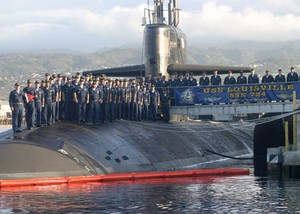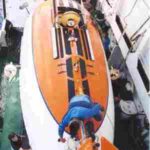“Of all the branches of men in the forces there is none which shows more devotion and faces grimmer perils than the submariners.” – attributed to Sir Winston Churchill
From the first moment a young sailor fresh from training steps onto a nuclear submarine, he finds he has entered a completely different world. A world made of steel covered in ugly green and gray paint, steep ladders, low ceilings, and tight passageways. A world of gears and motors, buttons and switches, lights and lamps, and bells and whistles. A world of zero privacy, a tiny place to sleep, horrible food, and a pervasive stench. He enjoys a brief moment of excitement when first hearing that dive alarm and the accompanying “Dive! Dive! Dive!“. But he soon learns that this is the only part of the movies he had seen that was true. And as he lays down on a pallet tied to torpedo racks, with grease dripping on his sheets and a tomahawk cruise missile for a bunkmate, at that moment he thinks: “Good Lord, what have I gotten myself into!?”
In the Navy
“Any man who may be asked in this century what he did to make his life worthwhile… can respond with a good deal of pride and satisfaction, I served in the United States Navy.” – JFK1
I was like any other young man fresh out of high school, diploma in hand, and a head full of dreams. I wanted to do something exciting, see the world, and forge a blazing trail into the future on my terms. I decided that college was something I would address at a later time in life, as I had big plans, important plans. I was going to join the US Navy. To a young man with such desires as I’d had, the Navy simply offered it all. The world on a plate, a fancy uniform, and an excitement level to match my ambitions. Or so the recruiters told me. But they were Navy men…surely they were telling the truth, right?
So I enlisted as an Electrician’s Mate in the Navy Nuclear Program and volunteered for the Submarine Service. I will admit that the combination of the words “nuclear” and “submarine” were too much for an idealistic kid such as myself to pass up. I was able to get through boot camp at the Great Lakes NTC in Illinois, “A” School and Nuclear Power School in Orlando, Fl, and the Navy Nuclear Power Training Unit in Ballston Spa, NY with no problems. I was ready for the big time now, after almost 2 years of training. It was time for my first boat.
Das Boot
“Submarine life most of the time is hours and hours of boredom with intermittent terror thrown in to keep you on your toes!”2
I finally reported to the U.S.S. Louisville (SSN724) in Guam after being “forced” to wait in the island paradise of Oahu, Hawai’i. The story of the typical fresh submariner in the beginning of this article was my true-to-life first experience. My first introduction to the submariner’s life began with a “stores load”. This entails everyone lining up on the top deck and down one of the hatches (which double as emergency escape trunks on a submarine) and hand carrying food items like a bucket brigade to restock the ship. Under the hot Guam sun, handling frozen food is a very messy business, and can even be dangerous.
In this particular event, I witnessed the most uncanny of sights. A box of frozen fish had a broken corner just big enough for a whole fish to slip though. And slip through it did, falling a dozen or so feet downward, striking with frozen rock-solid force, the poor sailor standing at the bottom. The malicious fish had cut the poor kid above the eye so that he had to have stitches. This was performed by the “Doc”, who is not a doctor but a specially trained medic, while the sailor was laying on the wardroom table (where the officers eat). Such is the medical facilities aboard a submarine, and it was in the best interest of a sailor to not get sick or injured unless in home port.
Life on the boat exists in modified 18-hour days. While the days are still counted in 24 hour increments like anywhere else, the standard rotation for a submariner will be 6 hours of watch, 6 hours of maintenance and training, and 6 hours of sleep. This is repeated ad nauseum for an entire patrol or deployment. You are, for all intents and purposes, on duty 24/7 while out to sea.
There are no days off. There is no food, but what the galley serves during the brief meal periods. Recreation involves reading (if you can store enough books), watching a movie you have seen a dozen times and hated the first time, or sleeping. Most submariners opt for the latter. Sleep is also known as “time travel” on board a submarine, as it makes the unbearable time go by.
No rest for the weary
“Life is not fair, life was not meant to be fair. We in the submarine service are fortunate to learn this fact early in life, that life is not fair..” 2
The sleeping arrangements are worse than you could imagine. A bunk consists of a very thin mattress approximately 30 inches in width and 6 feet in length, housed inside of a compartment with a hollow bottom which has many of the same qualities as a coffin. These sleeping compartments are stacked three high with up to 36 total in a berthing area the size of an average living room. If you are lucky, they were able to stick all of the snorers into one of the smaller berthing areas.
Storage for clothing and everything else you need is stowed in the hollow portion of the rack, under the mattress. It is about 4 inches deep, and the same length and width as the mattress. This leaves little room for all but necessities for a 6-month voyage, especially when you may have to share that bunk, and its storage space with another person.
“Hot racking” is the method of sharing bunks between personnel. this is done because there simply aren’t enough beds for the 120+ crew members on a fast-attack submarine. The term refers to the rack (bunk/bed) always being “hot” since while one crew member is on watch or performing maintenance duties, the other will be sleeping. It is a very unpleasant experience.
There are so few racks on a submarine, that the lowest ranking members may not get a bunk at all, but will have to sleep in the torpedo room. Any empty torpedo racks are thus converted into berthing by strapping down wooden boards with mattresses on them. I spent my first months on the boat sleeping in just such an arrangement, with grease from the racks dripping on top of me, a torpedo above my head, and a tomahawk cruise missile stowed to my left. Strange bedfellows indeed.
I Have the Watch!
“Diving Officer, I believe we are airborne.”2
Watch standing is the primary duty of any sailor in the Navy, submarine or otherwise. A standard watch is 6 hours long, and consists of operating machinery or controls, logging meters or gauges, and taking account of everything that happens during your watch. Perhaps the most important aspect of watch standing is responding to casualties. Submarines constantly run casualty drills. When you are hundreds of feet beneath the ocean surface, a casualty can lead to a quick death, and so it is important that every member of the crew can respond quickly and efficiently to put the boat in a safe state.
Unfortunately, it is almost a guaranteed rule that drills will commence while you are sleeping. If you can picture climbing into your bed after a long day at work, drifting off to sleep, and then suddenly alarms go off and the lights come on, people start running all over the place, and everyone is yelling, then you might get the general idea of what drills are like. On a submarine, it can happen several times in your 6 hours off, all day, or all week. And it is common for a drill to lead into a “field day”.
A field day is generally a 2-3 hours long cleaning session in which the entire crew, except those on watch, participate. This usually entails wiping the same spot for hours while Chief Petty Officers walk around with giant flashlights looking for dirt and sleeping sailors.
Submarine Warriors of the Briney Deep
“You call this bad? I’ll tell you what bad is….Bad is passing test depth at 80 feet per second with a thirty degree down bubble. Compared to that, this is a walk in the park.” 2
I’ve often been asked if serving on a submarine is dangerous.The answer is a solid yes. You live in a low-oxygen environment, kept so because if a fire starts it could move through the whole boat in a matter of minutes. You are in a steel tube being compressed by a massive amount of sea water, just trying to find its way in. You have to put your life in the hands of your crew mates every time you go to sleep. And the only way to escape a sinking submarine has about a 30% survival rate. With the endless training, however, the dangers are minimized as is evidenced by how few submarines have been lost at sea.
It would seem like this is a lot for a young man to deal with. The good news is, you learn not to think about these things. A submarine is so steady when going straight and well under the water, that it can almost feel like a building. Of course, you are quickly reminded of your actual situation as soon as the boat turns or goes up and down. And to answer the most asked question about submarines, yes they go deep. Per the Navy’s website, they can go deeper than 800 feet.
It would be difficult to describe exactly what it is like from a day-to-day perspective to a person that has never seen it first hand. I have found a few good sites on the Internet that attempt to do just that. A fine example is Submarine Simulation, a step by step guide on how to simulate life on a submarine in your own home.
Sources
1. http://www.history.navy.mil/trivia/trivia02.htm
2. http://www.submarinesailor.com/quote.asp
3. http://www.navy.mil/navydata/cno/n87/faq.html





